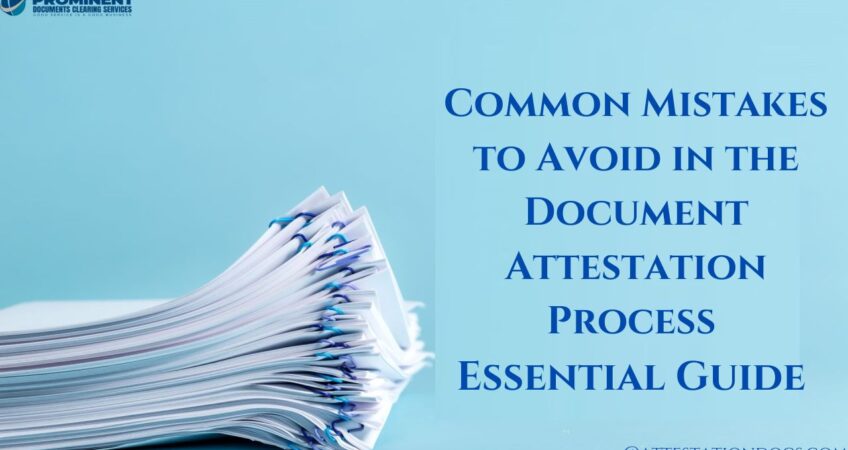
Common Mistakes to Avoid in the Document Attestation Process
The document attestation process can be daunting, especially for those unfamiliar with the specific requirements and steps involved. Unfortunately, common mistakes in preparing documents for attestation often lead to unnecessary delays, additional costs, and, in some cases, outright rejection of documents. This guide highlights some of the most common errors people make during document attestation and offers practical tips on how to avoid them.
1. Not Understanding the Type of Attestation Required
One of the first steps in document attestation is identifying the correct type of attestation needed based on the purpose, destination country, and type of document. For example, educational certificates often require a different attestation process compared to business or personal documents. Certain countries may require a more rigorous, multi-step verification process. Failing to research the type of attestation required can lead to missed steps, which can result in rejected documents.
Solution: Start by consulting the embassy or consulate of the country for which the document is being attested. Alternatively, a reputable attestation service provider can guide you on the appropriate process.
2. Submitting Incomplete or Incorrect Paperwork
Document attestation is a precise process, and submitting incomplete or incorrect paperwork can be a significant setback. People often miss necessary details, such as leaving blank fields or failing to include specific information on forms. Missing out on supporting documents, such as identification copies, prior notarizations, or translations, is another common error that can invalidate the attestation.
Solution: Before submission, double-check that every required document is complete and contains accurate information. Prepare a checklist that includes all essential documents and review it to ensure nothing is overlooked. If necessary, consult with an attestation professional to verify your documents.
3. Ignoring the Importance of Notarization
Notarization is typically the first step in the attestation process. Skipping this step or not understanding its significance is a mistake that can delay the attestation process. Notarization validates the authenticity of the document, and most authorities will not accept documents for further attestation without it.
Solution: Ensure that your documents are properly notarized before proceeding to the next stages of attestation. If you are unsure where to begin, many attestation service providers offer notarization services as part of their package, which can streamline the process.
4. Failing to Include Necessary Translations
If the document to be attested is in a language other than the official language of the country where it will be used, a certified translation is usually required. Submitting a document in the wrong language or without a certified translation can lead to outright rejection. Some people mistakenly assume that all countries accept English documents, but this is not the case.
Solution: Research the language requirements for the attesting country and ensure that you have an accurate, certified translation if needed. Many embassies or consulates provide a list of approved translation services, which can be helpful in ensuring accuracy and avoiding delays.
5. Using Unauthorized or Unreliable Attestation Service Providers
Some people make the mistake of using unauthorized or unreliable attestation providers to save time or money, only to find their documents returned or invalidated. Choosing an unauthorized service can lead to poor-quality attestation, missing documentation, and legal issues. A professional attestation service must be authorized and well-versed in the processes for different types of documents and countries.
Solution: Research and select a reputable attestation provider with experience in handling attestation for your specific destination country. Look for reviews, certifications, and accreditations to confirm the service provider’s credibility. This investment can save time and prevent headaches down the road.
6. Failing to Account for Processing Time
Many people underestimate the time it takes for document attestation. The process can take several weeks or even months depending on the type of document and the country’s requirements. Rushing to submit documents last minute often results in errors, delays, and stress.
Solution: Plan ahead and allow ample time for the attestation process, especially if you’re working with a tight deadline. Contact the relevant embassy, consulate, or attestation provider to get an estimate of processing times, and account for any potential delays.
7. Overlooking Apostille Requirements
For documents being used in countries that are part of the Hague Convention, an apostille is often required instead of the typical attestation process. An apostille serves as an internationally recognized attestation that replaces the need for additional embassy-level attestation. Overlooking this requirement can lead to redundant steps and wasted time.
Solution: If you’re sending documents to a country that’s part of the Hague Convention, check whether an apostille will suffice instead of traditional attestation. The Department of State (or equivalent authority) in your country typically provides apostille services for such purposes.
8. Failing to Maintain Copies of All Documents
During the attestation process, documents often pass through various departments and stages, which increases the risk of them getting lost. Not having copies of all the documents can make it challenging to recover in case anything is misplaced, especially when dealing with original certificates or legal documents.
Solution: Always keep digital and physical copies of every document you submit for attestation. This will make it easier to track your documents, reproduce them if necessary, and have backup records for future needs.
Conclusion
The document attestation process is complex, with different countries and institutions having unique requirements that can complicate the procedure. However, by understanding and avoiding these common mistakes, you can make the process smoother, quicker, and more efficient. When in doubt, consulting a reputable attestation provider can provide you with valuable guidance, help you sidestep potential errors, and ensure that your documents meet all the necessary requirements. Following these tips will save you time, reduce stress, and increase the chances of successfully attesting your documents for international use.
